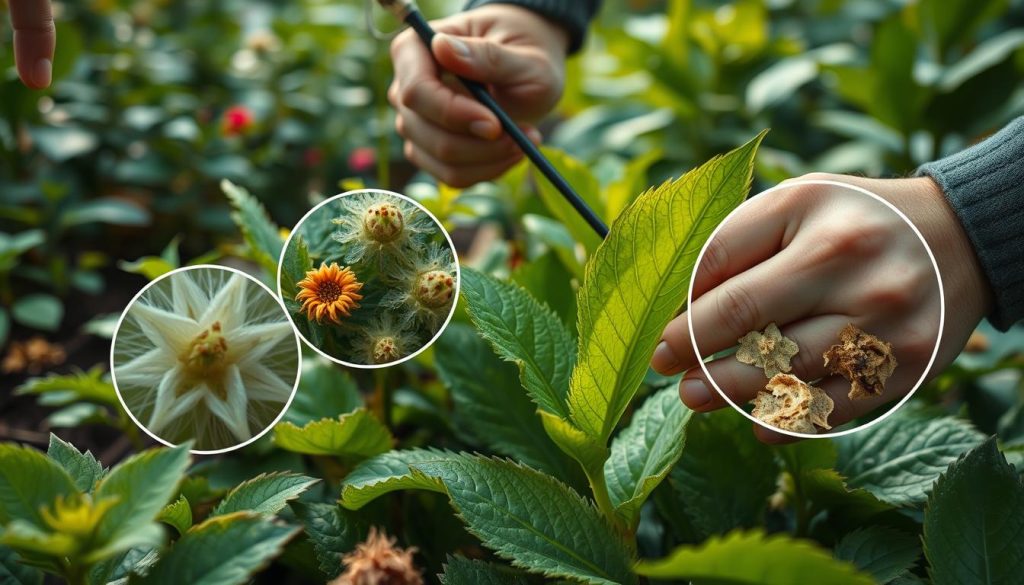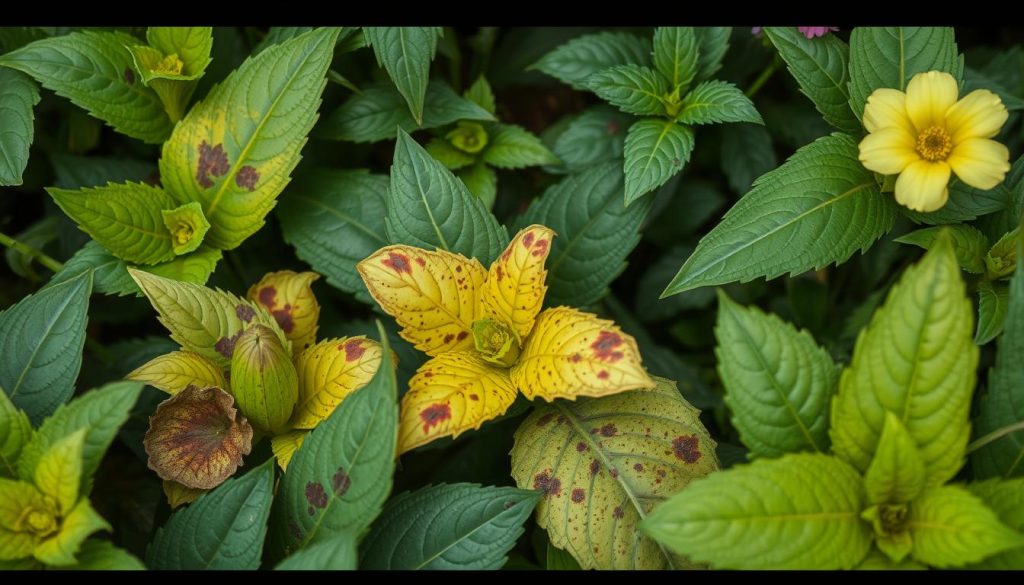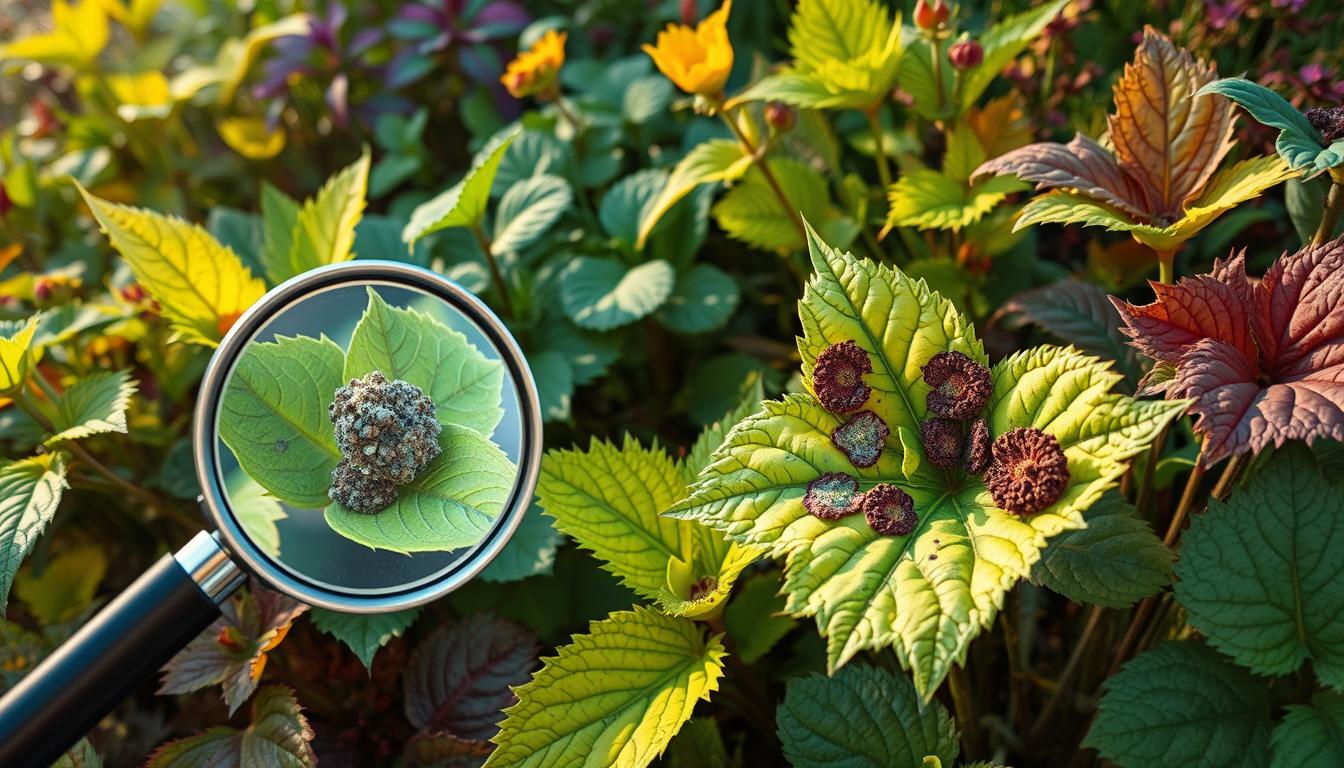As a gardener, I aim to help others spot and fix common plant diseases. Finding out what’s wrong with your plants can be tough. But, with the right info, you can figure out and fix the problem.
Knowing how to identify plant diseases is key. You need to understand the signs, reasons, and fixes for fungal, bacterial, and viral infections.
Diagnosing plant diseases is vital to stop them from spreading and keep plants healthy. By knowing the main signs, causes, and fixes, gardeners can act fast to protect their plants. In this article, I’ll share a detailed guide on identifying plant diseases. We’ll cover why early detection and treatment are so important.
Introduction to Plant Diseases
As a gardener, I’ve learned that stopping diseases before they start is key. I keep a close eye on my plants to catch any problems early. This way, I can stop diseases from spreading.
By watching my plants closely, I can spot any health changes quickly. This lets me act fast and keep other plants safe. It’s saved me from expensive treatments and kept my garden healthy.
Why I Focus on Plant Health
I make plant health a top priority because it’s essential for my garden’s health. Healthy plants are less likely to get sick. This also helps me catch diseases early, which is crucial for treating them effectively.
The Importance of Early Detection
Spotting diseases early is key to stopping them from spreading. If I catch a problem early, I can treat the plant and keep others safe. Some common signs of disease include:
- Unusual growth patterns
- Discoloration or spotting on leaves
- Wilting or yellowing leaves

Knowing these signs and acting fast helps me keep my garden healthy. Regular checks and quick action are vital for stopping diseases in their tracks.
Common Symptoms of Plant Diseases
As a gardener, knowing the signs of plant diseases is key. This knowledge helps you act fast and stop damage. Spotting symptoms like wilting leaves, spots, and odd growth is vital for treating diseases.
Wilting and Yellowing Leaves
Wilting and yellow leaves often point to problems like root rot or lack of nutrients. It’s important to look into these signs to find the root cause.
Spotting and Discoloration
Spots and color changes on leaves or stems can mean fungal or bacterial infections. These signs help pinpoint the disease type and guide treatment.
Unusual Growth Patterns
Odd growth, like twisted or stunted plants, might be due to viruses or fungi. It’s crucial to examine these symptoms closely for a full diagnosis.
Some common symptoms of plant diseases include:
- Wilting or yellowing leaves
- Spotting or discoloration on leaves or stems
- Unusual growth patterns
- Black or white powdery patches on leaves

Knowing these symptoms and acting early can prevent disease spread. Always watch your plants and get expert help if unsure about diagnosing diseases.
Fungal Diseases: My Observations
I’ve learned how key it is to spot plant diseases. Fungal diseases are common and can be caused by too much water, bad air flow, and high humidity.
Spotting fungal infections early is key to stopping disease spread. Look out for white powdery patches, black spots, and yellow leaves.
Recognizing Fungal Infections
Regularly check your plants for any odd changes. This way, you can act fast and stop the disease from getting worse.
Popular Types of Fungal Diseases
Fungal diseases like powdery mildew, leaf spot, and root rot are common. Each has its own signs and needs a specific treatment.

Treatments That Work for Me
To fight fungal diseases, I use fungicides and cut out infected parts. Also, better air flow, less water, and the right nutrients help keep diseases away.
Bacterial Diseases: What to Look For
I’m diving into the world of plant diseases, focusing on bacterial ones. These diseases can come from too much water and poor cleanliness. Knowing the signs and how to prevent them is key.
Identifying Bacterial Infections
Spotting bacterial diseases in plants is important. Look for a slimy feel, bad smells, and color changes. Catching these signs early helps stop the disease from spreading.
Common Bacterial Plant Issues
Some common problems include:
- Leaf spot
- Blight
- Crown gall
These issues stem from different bacteria. Knowing the causes and symptoms helps treat them effectively.

Care Tips for Affected Plants
For plants with bacterial diseases, ensure good air flow and remove sick leaves. Also, don’t overwater. These steps help stop the disease and encourage healthy growth. Understanding and preventing plant diseases keeps your plants in top shape.
Viral Diseases and Their Symptoms
I’m diving into the world of plant diseases, focusing on viral ones. These diseases come from many sources, like insects and dirty tools. Knowing what causes and shows symptoms of viral diseases helps us treat them better.
Finding out if a plant has a viral disease can be tough. But, there are some signs to look for. These include:
- Unusual growth patterns
- Discoloration or mottling of leaves
- Stunted or distorted plant growth
Understanding Virus Transmission
Viruses can spread in many ways, like through insects, dirty tools, and even people. It’s key to prevent these diseases from spreading.
Symptoms to Watch Out For
Spotting viral diseases in plants is important. Look for yellow or brown leaves, slow growth, and weird plant shapes.
Managing Viral Infections
Even though we can’t cure viral diseases, we can manage them. Remove sick plants, clean tools, and choose strong plant types.
Environmental Factors Affecting Plant Health
Learning about plant diseases shows me how key environmental factors are. Humidity and temperature greatly affect whether plants grow well or get sick.
When we talk about plant diseases, we must think about the environment. Here are some important points:
- Humidity: High humidity can lead to fungal diseases, while low humidity can cause bacterial diseases.
- Temperature: Extreme temperatures can weaken plants, making them more susceptible to disease.
- Soil quality: Poor soil quality can lead to nutrient deficiencies, making plants more vulnerable to disease.
To help plants grow well, I suggest these watering tips:
| Watering Practice | Benefits |
|---|---|
| Regular watering | Prevents water stress, reducing the risk of disease |
| Soil monitoring | Helps identify nutrient deficiencies, allowing for prompt correction |
Understanding how environment affects plant health helps us create a better space for them. This way, we can lower disease risk and encourage healthy growth.
Tools and Resources for Diagnosis
Diagnosing plant diseases can be easier with the right tools and resources. I’m passionate about it and have found many helpful resources. From mobile apps to field guides and online communities, there are many ways to start diagnosing plant diseases.
Using Mobile Apps for Identification
Mobile apps are a great starting point. Apps like PlantSnap and Leafspot let you upload plant photos. They then give you identification and treatment tips.
Field Guides That Help
Field guides are also very useful. They offer detailed info on plant diseases. You can find symptoms, causes, and treatments in guides like the “Plant Disease Handbook” and the “Gardener’s Guide to Plant Diseases.
Online Communities to Join
Online communities are great for connecting with other gardeners. Places like the “Plant Disease Forum” and the “Gardening Community Forum” are full of people who share your interest.
With these tools and resources, gardeners can feel more confident in diagnosing and treating plant diseases. Whether you’re experienced or new, there’s plenty of help out there for plant pathology diagnosis and diagnosing plant diseases.
- Mobile apps: PlantSnap, Leafspot
- Field guides: Plant Disease Handbook, Gardener’s Guide to Plant Diseases
- Online communities: Plant Disease Forum, Gardening Community Forum
Preventative Measures I Take
To stop plant diseases, I do several things. Finding diseases early is key to stopping them. I watch my plants closely to catch problems early. This helps a lot in identifying diseases.
Some steps I take include:
- Regularly monitoring my plants for signs of disease or pests
- Using resistant plant varieties to reduce the risk of disease
- Practicing good sanitation to prevent the spread of disease
Regular Monitoring
Watching my plants often is crucial. It helps me spot diseases early. This way, I can fix problems before they get worse.
Resistant Plant Varieties
Choosing resistant plants helps too. These plants are made to fight off diseases better. It lowers the chance of getting sick.
Importance of Sanitation
Cleanliness is also key. I make sure to clean tools and remove sick plants. Keeping the area tidy helps a lot.
By taking these steps, I keep my plants safe. Identifying diseases is a constant task. Being ready and proactive helps a lot.
When to Seek Professional Help
As a gardener, I’ve learned that sometimes you need professional help for plant diseases. DIY methods can work well, but they might not solve all problems. In tough cases, a pro can save your plants.
It’s key to know when DIY isn’t enough for plant disease diagnosis. If you’re not sure about a disease or how to fix it, get a pro’s opinion. They can give a correct diagnosis and suggest the best treatments.
Recognizing the Limits of DIY
Signs you might need a pro include unusual symptoms, ongoing issues, or no improvement with DIY fixes. If you see these, it’s time to call in a professional.
Finding Quality Plant Specialists
To find a good plant specialist, ask friends or family, check online reviews, or reach out to local nurseries or clubs. When choosing, ask about their experience, qualifications, and how they handle plant diseases.
Questions to Ask an Expert
- What experience do you have with plant disease diagnosis and treatment?
- What approach do you take to diagnosing and treating plant diseases?
- Can you provide examples of successful treatments or case studies?
Getting professional help when needed and working with a skilled plant specialist is crucial. It ensures the best care for your plants and boosts your chances of solving plant disease problems.
Conclusion: Staying Proactive in Garden Care
As we wrap up this guide on
identifying plant diseases
, it’s clear that staying ahead in garden care is key. Learning about plant health is crucial for a lively outdoor space. This journey is ongoing, but the benefits make it all worthwhile.
Keeping Learning About Plant Health
My dedication to
plant disease identification
never stops. I always look for new info, try out different methods, and connect with other gardeners. I urge you to do the same – keep learning and finding ways to improve your plants’ health.
My Commitment to Healthy Gardening
Healthy plant growth is my passion. By using the tips from this article, I’ve seen a big drop in disease in my garden. Seeing my plants flourish is incredibly rewarding, and I’m eager to share my knowledge with others.
Encouragement for Your Plant Journey
Every gardener’s path is different, and there’s always more to learn. Don’t let setbacks discourage you – see them as chances to grow and learn more. With a proactive mindset and a love for learning, you can create a vibrant garden that brings you joy for years.

